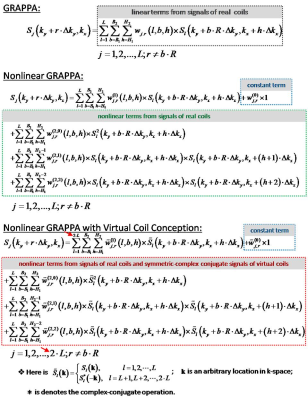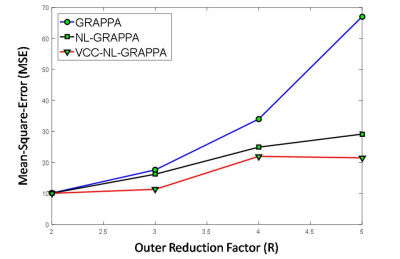3507
Nonlinear GRAPPA Reconstruction with Virtual Coil Conception1Shenzhen Institutes of Advanced Technology, Chinese Academy of Sciences, Shenzhen, China, 2Department of Computer Science and Technology Engineering, University of Houston-Downtown, Houston, TX, United States, 3Department of Biomedical Engineering and Department of Electrical Engineering, The State University of New York, Buffalo, NY, United States
Synopsis
Nonlinear GRAPPA is a kernel-based approach for improving parallel imaging reconstruction, by reducing noise-induced error. Virtual coil conception has been applied into the reconstruction process for parallel acquisitions, by generating virtual coils containing conjugate symmetric k-space signals from actual multiple-channel coils. In this work, we proposed a hybrid method to combine nonlinear GRAPPA and virtual coil conception for incorporating additional image- and coil-phase information into the reconstruction process. The experiments of in vivo human brain data show that the proposed method can reduce more noise and artifacts than the traditional GRAPPA and original Nonlinear GRAPPA methods.
Introduction
Recently, phase-constrained parallel MRI approaches have shown the potential for significantly improving the image quality of accelerated MRI scans 1. As one type of phase-constrained parallel MRI formulations, virtual coil conception (VCC) has been applied into the reconstruction process for parallel acquisitions, by generating virtual coils containing conjugate symmetric k-space signals from actual multiple-channel coils 2.There are many approaches 3-6 utilizing conjugate k-space symmetry to improve image quality in traditional parallel imaging approaches 7-9.Otherwise, Nonlinear GRAPPA (NL-GRAPPA) is a kernel-based approach for parallel imaging reconstruction, by mapping the k-space data onto a high-dimensional feature space and then linearly combining them to estimating the missing data10. For utilizing conjugate k-space symmetry in nonlinear parallel MRI approaches, the purpose of this study is to propose a hybrid method, named as VCC-NL-GRAPPA, to combine two different parallel MRI concepts, VCC 9 and NL-GRAPPA 10.The experiments of 8-channel in vivo human brain data show that the proposed method exhibits superior performance in terms of noise suppression and artifacts reduction than the traditional GRAPPA 9 and original NL-GRAPPA 10 methods.Theory and Methods
It is well-known that the conventional GRAPPA 9 fully samples the central k-space data as ACS dataset to estimate the weights and undersamples the outer k-space at outer reduction factors ($$$R$$$) to accelerate data acquisition. The missing k-space data can be estimated by a linear combination according to the estimated weights. As seen as Fig.1, $$$S_{j}\left(\begin{array}{c}k_{y}+b\cdot \triangle k_{y},k_{x}\end{array}\right)$$$ denotes the unacquired k-space signal at the target $$$j$$$-th coil; $$$S_{l}\left(\begin{array}{c}k_{y}+b\cdot R\cdot\triangle k_{y},k_{x}+h\cdot \triangle k_{x}\end{array}\right)$$$ denotes the acquired undersampled signal at the l-th coil, and $$$w, \widetilde{w}$$$ denote the linear combination coefficients; $$$R$$$ represents the outer reduction factor; l counts all coils; b and h respectively transverse the acquired neighboring k-space data along frequency-encoding(ky) and phase-encoding(kx) directions. As seen in Fig.1, GRAPPA 9 only has linear terms from real coils; NL-GRAPPA 10 has constant terms, linear and nonlinear terms from real coils; our proposed VCC-NL-GRAPPA has constant terms, linear and nonlinear terms from real coils, linear and nonlinear terms from symmetric-complex conjugate signals of virtual coils. Here, the maximum order terms are 2nd-order nonlinear terms. They can have other higher order terms as nonlinear terms 10. In the proposed VCC-NL-GRAPPA reconstruction procedure, firstly, both ACS and undersampled data of virtual coils are generated from those of real coils; secondly, weights are estimated by ACS dataset of real and virtual coils; thirdly, one standard linear combination reconstruction is performed to estimate the missing data of real and virtual coils; finally, the resulting images from ACS, undersampled and estimated data of real and virtual coils, are combined using a sum-of-squares (SoS) combination method.Results
The experimental dataset of axial human brain was acquired on a GE 3T scanner (GE Healthcare, Waukesha, WI) with an 8-channel head coil, which was acquired by a 2D spin echo sequence (TE/TR: 11/700 ms; matrix size: 256×256; FOV: 220 mm2). The data were fully sampled and manually undersmapled for reconstruction comparison. Fig. 2 and 3 show the reconstruction results and difference maps of GRAPPA 9, NL-GRAPPA 10 and VCC-NL-GRAPPA at the reduction factors of 3 and 5, respectively. These figures illustrate that the proposed method can not only reduce more artifacts but also suppress more noise thanGRAPPA 9 and NL-GRAPPA 10. Fig.4 illustrates that the values of mean-square-error (MSE) change with different outer reduction factors (R). VCC-NL-GRAPPA obviously expresses the slowest growth of MSE values, and has smaller MSE values at high outer reduction factors than GRAPPA 9 and NL-GRAPPA 10.Discussion and Conclusion
In sum, we proposed a hybrid method to combine VCC 2 and NL-GRAPPA 10 together for utilizing conjugate k-space symmetry to improve parallel MRI reconstruction. The reconstruction results of the proposed methods have shown the potential of suppressing noise and reducing artifacts at high outer reduction factors. In the future, more in vivo experiments, and the extension in simultaneous multiple-slice imaging 11 will be studied.Acknowledgements
Some of this work was supported in part by the National Natural Science Foundation of China (61471350) and the Science and Technology Program of Guangdong (2015A020214019).References
1. Blaimer M, Heim M, Neumann D, Jakob PM, Kannengiesser S, Breuer FA. Comparison of phase-constrained parallel MRI approaches: Analogies and differences. Magn Reson Med. 2016 Mar;75(3):1086-99.
2. Blaimer M, Gutberlet M, Kellman P, Breuer FA, Kostler H, Griswold MA. Virtual coil concept for improved parallel MRI employing conjugate symmetric signals. Magn Reson Med. 2009 Jan;61(1):93-102.
3. Huang F, Lin W, Duensing GR, Reykowski A. K-t sparse GROWL: sequential combination of partially parallel imaging and compressed sensing in k-t space using flexible virtual coil. Magn Reson Med. 2012 Sep;68(3):772-82.
4. Xu L, Feng Y, Liu X, Kang L, Chen W. Robust GRAPPA reconstruction using sparse multi-kernel learning with least squares support vector regression. Magn Reson Imaging. 2014 Jan;32(1):91-101.
5. Beatty PJ, Chang S, Holmes JH, Wang K, Brau AC, Reeder SB, Brittain JH. Design of k-space channel combination kernels and integration with parallel imaging. Magn Reson Med. 2014 Jun;71(6):2139-54.
6. Uecker M, Lustig M. Estimating absolute-phase maps using ESPIRiT and virtual conjugate coils. Magn Reson Med. 2017 Mar;77(3):1201-1207.
7. Sodickson DK, Manning WJ. Simultaneous acquisition of spatial harmonics (SMASH): fast imaging with radiofrequency coil arrays. Magn Reson Med. 1997 Oct;38(4):591-603.
8. Pruessmann KP, Weiger M, Scheidegger MB, Boesiger P. SENSE: sensitivity encoding for fast MRI.Magn Reson Med. 1999 Nov;42(5):952-62.
9. Griswold MA, Jakob PM, Heidemann RM, Nittka M, Jellus V, Wang J, Kiefer B, Haase A. Generalized autocalibrating partially parallel acquisitions (GRAPPA). Magn Reson Med. 2002 Jun;47(6):1202-10.
10. Chang Y, Liang D, Ying L. Nonlinear GRAPPA: a kernel approach to parallel MRI reconstruction.Magn Reson Med. 2012 Sep;68(3):730-40.
11. Setsompop K, Gagoski BA, Polimeni JR, Witzel T, Wedeen VJ, Wald LL. Blipped-controlled aliasing in parallel imaging for simultaneous multislice echo planar imaging with reduced g-factor penalty. Magn Reson Med. 2012 May; 67(5):1210-24.
Figures



